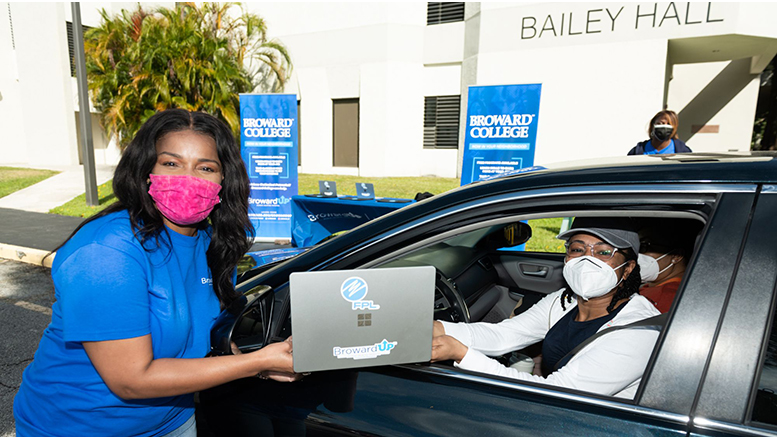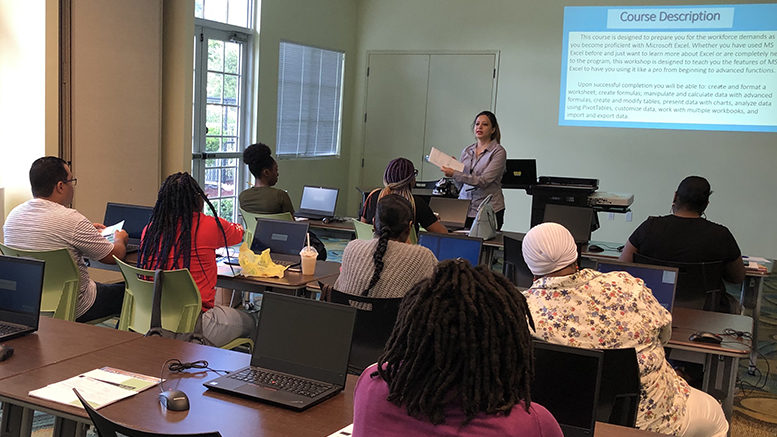A deep dive into data helped officials at Florida’s Broward College understand who they were reaching and, more importantly, who they weren’t. It led to a transformative program serving Broward County – a program that just received a groundbreaking $30 million federal grant.
When Gregory Adam Haile began his presidency at the college in 2018, a push began to really study the available equity data, not just from the college, but also from the entire service area. From a distance, Broward County looked good. The overall unemployment rate was 3% to 4%, and the county had a 44% postsecondary education attainment rate.
But a closer look revealed that within six ZIP codes in the county – some of the biggest zip codes in the county – the unemployment rate was 9% to 15%, and the education attainment rate was about 27%.
Broward College served 63,000 students, but only about 3,000 were from those six ZIP codes, where the income level was low and a majority of residents are Black and Hispanic.
Only one of the college’s 10 locations was near those communities.
There was a clear service gap.
“We knew we had to do something different than what we’d done,” says Mildred Coyne, senior vice president for workforce education and innovation at the college.
Leveling up adults
Broward College had deep partnerships with many organizations in the county, such as the Urban League of Broward County, the Boys and Girls Club, the YMCA and the Jack & Jill Center.
“We went to our partners and said, ‘How can we be more intentional about getting people more comfortable with college?’” Coyne says. “College wasn’t really a concept in some of those communities. That was part of what we had to change.”
A lot of the college’s partners served the community’s children. Broward College now needed to serve the parents, creating a two-generation service model.
“We needed to level-up the adults,” Coyne says.
And they needed to do it by coming into the communities.
The college received a grant from the Florida governor’s office that it could use to provide free workforce training to adults, in their own neighborhoods, in partnership with the Urban League. President Haile and his family also committed $100,000 to providing equitable access to college.

The official launch of Broward UP (the UP stands for “unlimited potential”) was in 2018 and the program was lauded by Haile at his investiture ceremony in early 2019.
“We believe that every individual and every community in our county has Unlimited Potential,” Haile said during the ceremony. “We are committed to developing community partnerships in which we can leverage our resources to improve the quality of life starting with communities in ZIP codes with high unemployment and where relatively few people attain certificates and degrees. These are our Broward UP communities. These are the communities with unlimited potential.”
Moving quickly
The college and its partners moved quickly to get the college into the neighborhoods. In a short amount of time, there were eight locations within those six ZIP codes where classes were being offered for free.
“We were taking away obstacles of time, transportation and resources needed to get to us,” Coyne says.
To prove that everyone involved was committed, and that partnerships were mutually beneficial, memorandums of understanding (MOUs) with partners were signed – and celebrated.
Broward College also signed MOUs with municipalities. There are 12 cities within the six ZIP codes, and those city leaders helped to elevate the college’s connection to the community. They requested Broward College flags and signs and other branding for their cities, “making it inescapable for people to see that college was an opportunity for them,” Coyne says.
Thinking bigger
Delivering classes in communities was a good start, but it wasn’t enough.
“I kind of liken it to an entrepreneurial model,” Coyne says. “You do discovery, test your product and continue to pivot and iterate until you find the sweet spot.”
There was a lot of adjusting in those early days – and “bootstrapping” to keep the program funded.
There were three goals for Broward UP: increase access to college, increase attainment rates and provide holistic supports.
The governor’s grant that helped launch the program was restrictive and the college could only offer one certification per participant. A sizable grant from a family foundation “loosened the ground under us,” according to Coyne, allowing the college to offer more certifications. That funding also helped to build up case management so participants were provided with wraparound supports.
The college was able to hire three people to be “in the field” to support students. The case management model was launched at the beginning of the pandemic.
The pandemic led to another adjustment.
“We weren’t ever thinking about this being a remote environment,” Coyne says. “It made us test assumptions.”
With the help of a grant, Broward College bought laptops and hotspots for Broward UP participants, and they’re having success with remote classes in communities, “which further expands our ability to reach adults,” says Coyne.
The next puzzle piece
As Broward UP continues to grow, so has the financial support.
This summer, the college received a $30 million gift from philanthropist MacKenzie Scott, ensuring Broward UP could live on in perpetuity. That gift – along with other investments – also will help with the next piece of the puzzle: employment solutions.
“We need to be deliberate about job placement,” Coyne says. “For resiliency, people need education. But still, some people just need a job now.”
The college hired employment specialists to not only connect students to jobs but also coach them in those jobs, rather than turning them loose when they are hired.

And now, a new grant is further validating the work of Broward College and its partners. The college received a five-year, $30 million Promise Neighborhoods grant from the U.S. Education Department in October. It’s one of only seven recipients of this grant in the nation.
The funding will help build a cradle-to-college-to-career pipeline within the Broward UP communities. It will expand the number of case managers, and there is funding for research around economic mobility. But measuring economic mobility is no easy feat, Coyne says.
“Current structures in higher ed don’t allow us to get real-time data,” she says.
Research partners and external evaluators are built into the grant. “It will help us show the efficacy for replication. This could be replicated,” Coyne says.
There’s also a technology component. All the Broward UP partners provide resources. Now, they can find technology solutions to “knit together” case management so all the resources can be found on one dashboard.
The Promise Neighborhood grant – and all the recent funding – signal to the community that “we are never leaving,” Coyne says.
“We’re all just thinking, ‘This is happening, we are on to something here,’” she says. “It’s so incredibly exciting to see it all unfolding. It’s what you dream about.”

